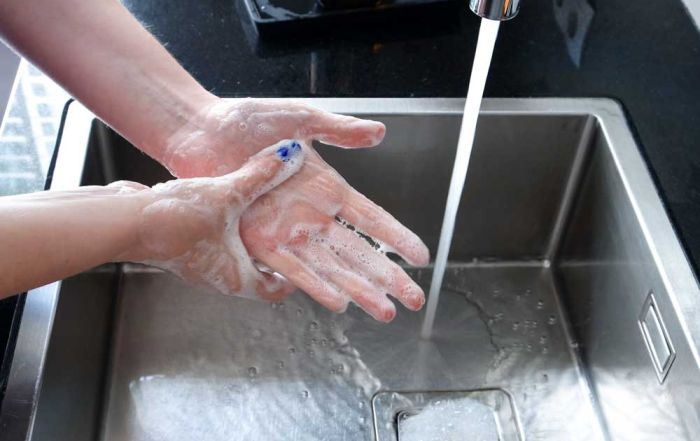Communicating Food Safety Messages
In our first blog for October, we reviewed the fundamentals of effective communication. We suggested considering the framework of Who, What, When, Where, and How for crafting messages and determining the best method for delivery. In this blog, we provide some suggestions on how to effectively message about correct handwashing and glove use, as these are fundamental safe food handling practices.
Correct handwashing by employees is often hit or miss. Research shows that staff know when and how to wash hands correctly, but don’t always act on that knowledge due to time availability, lack of supplies, or not being aware of the critical nature of handwashing. The message of why, when and how to wash hands in a foodservice setting needs to be conveyed. Managers cannot assume all employees know correct handwashing methods. Believe us, we have conducted extensive observational research in a variety of foodservices and the “splash and dash” approach is quite prevalent. FoodHandler® has created a variety of tools to convey the message about correct handwashing. There are videos that explain what to do and why it is important, which can be helpful in getting the message across. Posters and other signage that can be used to reinforce the message in the operation are also available. Standard Operating Procedures on handwashing expectations should be included in employee handbooks as well as the organization’s food safety plan. There are sample modifiable templates available at www.iowafoodsafety.org.
Using these resources incorporates different delivery methods that recognizes employees are individuals who each have unique learning styles, as Dr. Susan Arendt recommended in the September webinar. The visual-based learners will appreciate the videos and posters while those who learn best by reading will use the SOP as a guide. As managers, the key is to have these tools to show to staff along with communicating the expectation that this is how we do things here! If someone sees someone NOT washing hands when and how they should, then they should say something. It should be considered OK in your foodservice for one worker to remind another; we all should appreciate these nudges because everyone knows it is easy in the fast-paced environment to forget! Which leads us to how you communicate with customers about handwashing. How many times have you, as a customer, gone into the restroom in a foodservice operation and find it is unkempt – there are no basic supplies of soap or paper towels? Your first thought might be (ours certainly has been) – how are employees washing their hands? Many customers will first scope out a foodservice’s restroom before making the dining decision (we admit to doing that, and we are not alone). The restroom signifies an operation’s commitment to cleanliness, which is a foundation for food safety. Lack of a clean environment would raise questions about the manager’s commitment to food safety. If basic things are not done, then what corners are they cutting in the kitchen, which is usually not in the public eye? Of course the restroom is just one example of how messages about food safety can be communicated to customers. Managers have responsibility for the operation’s success. Communicating effectively through words, visuals, or practices is a big part of that responsibility. Effective messaging about food safety is one risk reduction strategy that should be taken. Risk Nothing!

READ MORE POSTS
30 Years Later: The Foodborne Illness Outbreak that Changed Food Safety
In January, we hit a major anniversary. One I am betting snuck by many of you – including me! January marked 30 years since the deadly 1993 E. coli O157:H7 outbreak at Jack in the Box restaurants on the west coast. The anniversary wasn’t on any of the major news networks that I recall. It did make it into a few newspapers, at least one or two of the newspapers that are left. It wasn’t until late-February that I realized it.
Does Temperature Really Matter when Washing your Hands?
In January, I reviewed the changes to the 2022 Food Code in my blog (check out Part I and Part II), and one change to the food code that I had mentioned, but didn’t discuss in-depth, was the change that lowered the water temperature a hand sink was required to produce to 85°F, as noted in Section 2-202.12 of the code. This requirement has been in place since the publishing of the 2001 Food Code, which required a water temperature of 100°F. Prior to this, 110°F was required (see the 1999 Food Code). So why the change and does water temperature when washing your hands really matter?
Hand sinks: Often Taken for Granted, but an Essential Part to Effective Hand Hygiene
Late in January, I received a question about hand sinks in a foodservice operation. The question pertained to school staff (teachers and aides) who were using a hand washing sink in the school kitchen. The question came as a matter of who was allowed access to the kitchen to use the sink, but the question itself caused me to go down a rabbit hole of requirements for hand washing sinks in foodservice operations.
Hot off the Press: The 2022 Model Food Code has been Released! Part Two.
Earlier in the month, we started a discussion about the changes to the 2022 Food Code. If you missed that post, late in December 2022, the Food and Drug Administration released the 2022 Food Code and I wanted to highlight a few of the changes that have been made to the code.










